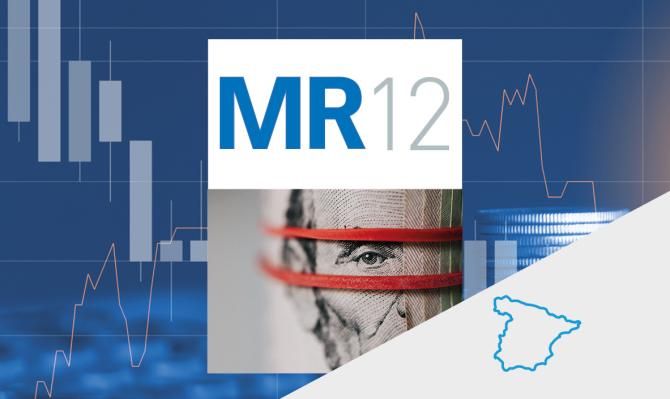The Spanish economy maintains a similar growth rate to the previous quarter

This time last year, the forecasts for our economy were not exactly flattering. Still mired in a severe energy crisis, the analyst consensus in December 2022 foreshadowed GDP growth of around 0.8% for 2023 as a whole, with negative figures even expected in one of the earlier quarters of the year. Fortunately, these predictions did not materialise and all the indicators suggest that the year will end with a very respectable growth of 2.4%, largely thanks to the energy crisis dissipating quicker than expected and the boost provided by the foreign sector. However, with the sharp cumulative rise in interest rates since July 2022, totalling 450 bps, it is foreseeable that the economy will begin 2024 dragging its feet. The speed and intensity with which the ECB has had to raise rates has been reflected in the revisions of analysts’ forecasts for 2024. Whereas at the beginning of 2023 the consensus estimate for GDP growth in 2024 was of around 2%, as of November 2023 it stood at 1.3%, a figure very close to CaixaBank Research’s own forecast of 1.4%. However, while the impact of the interest rate rise will be significant, there will still be support factors that will allow the economy to continue to grow, albeit at a slower pace. These include the strength of the labour market, which helps to boost confidence and household incomes, and the support from European funds.

The PMI for the services sector recorded an average of 51.1 points between October and November, a figure very similar to that of Q3, at 50.9 points, and slightly above the threshold that denotes growth. In contrast, the counterpart indicator for the manufacturing sector weakened slightly, averaging 45.7 points so far this quarter, down from 47.3 points in the previous quarter. Industrial production, meanwhile, grew by 0.1% up until October compared to the previous quarter average (–0.6% quarter-on-quarter in Q3) and retail sales, also to October, remained flat in quarter-on-quarter terms. Within the set of consumption indicators, the durable goods segment seems to be faring somewhat better, with vehicle registrations increasing by 6.5% quarter-on-quarter based on data up to November, compared to a 4.8% increase in the previous quarter. Also, CaixaBank Research’s consumption indicator, based on card data, shows a rebound in spending in November following the slump in October. Specifically, spending grew in November by 7.0% year-on-year, exceeding the average growth in Q3 of 5.5%. Finally, as we will see below, the labour market continues to generate employment, albeit at a slightly lower rate, at 0.1% quarter-on-quarter based on data up to November, compared to the 0.2% registered in Q3. Thus, with its nuances, the scoreboard of indicators shows a similar performance to the previous quarter, so it is reasonable to expect similar GDP growth as well (GDP grew by 0.3% quarter-on-quarter in Q3).

Although the number of registered workers fell in November (–11,583 people), as is commonplace before the start of the low season in the tourism sector, in seasonally adjusted terms employment continues to be created (+10,348), and the number of unemployed people continues to decline (–24,573 people). Thus, the total number of registered workers, with no seasonal adjustments, reached 20,806,074 workers, 522,443 more than a year ago, and the year-on-year rate stabilised at 2.6%.

Following the upturn in inflation during Q3, partly driven by the sharp rise in oil prices between July and September, we have seen signs of moderation in both October and November. In October inflation slowed its upward trend and stabilised at 3.5% and in November it decreased by 0.3 pps to 3.2%. Although this shift is partly due to the moderation in oil prices (Brent oil is at around 82 dollars/barrel ($/b) compared to $95/b at the end of September), not everything can be attributed to this channel. Core inflation, which excludes the energy component and unprocessed food, has also shown a marked moderation, standing at 4.5% in November, after registering 5.2% in October and 5.8% in September. Also, looking at the momentum of core inflation, a measure which better reflects recent price pressures, we see that in November it stood at 2.8%, hinting at a downward trend in the year-on-year rate of the core index in the coming months.

The current account, in 12-month cumulative terms, showed a surplus of 2.65% of GDP in September, the largest surplus since March 2018. The year-on-year comparison reveals an improvement in the balance, as a percentage of GDP, of 2.26 points. This was driven by the 3.18-pp improvement in the trade balance of goods and services, which more than offsets the 0.91-pp deterioration in the income balance, with the latter affected by the rise in interest rates. Within the trade balance, the improvements have been widespread, although the correction of the energy deficit stands out, having decreased by 1.08 pps due to the sharp fall in energy prices, which explains around 35% of the improvement in the total trade balance.

Both the appraisal value and the transaction price of unsubsidised ousing continued to show positive growth in Q3 2023 and accelerated the pace of that growth relative to the previous quarter (1.1% quarter-on-quarter vs. 0.3% in Q2 for the appraisal value, and 2.5% quarter-on-quarter vs. 2.1% in Q2 in the case of transaction prices). Thus, the year-on-year rates accelerated to 4.2% from 3.0% in Q2, in the case of the appraised value, and to 4.5% from 3.6% for transaction prices. This resilience in home prices despite the loss of momentum in demand, with an 8.5% drop in the number of sales in the year to date, appears to reflect a persistent shortage of supply, affected by the low level of planning permissions being granted for new homes.



